Tunisian dinar
The dinar (Arabic: دينار, French: Dinar, ISO 4217 currency code: TND) is the currency of Tunisia. It is subdivided into 1000 milim or millimes (ملّيم). The abbreviation DT is often used in Tunisia, although writing "dinar" after the amount is also acceptable (TND is less colloquial, and tends to be used more in financial circles); the abbreviation TD is also mentioned in a few places, but is less frequently used, given the common use of the French language in Tunisia, and the French derivation of DT (i.e., Dinar tunisien).
| Tunisian dinar | |
|---|---|
| دينار تونسي (Tunisian Arabic) دينار تونسي (Arabic) Dinar tunisien (French) | |
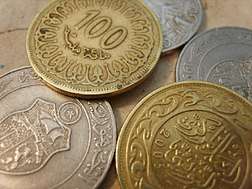 Tunisian dinars and millimes | |
| ISO 4217 | |
| Code | TND |
| Denominations | |
| Subunit | |
| 1/1000 | milim or millime |
| Symbol | د.ت (Tunisian Arabic) or DT (Latin) |
| Banknotes | |
| Freq. used | 5, 10, 20 dinars |
| Rarely used | 50 dinars |
| Coins | |
| Freq. used | 10, 20, 50, 100, 200 millimes; 1⁄2, 1, 2, 5 dinars |
| Rarely used | 1, 5 millimes |
| Demographics | |
| User(s) | |
| Issuance | |
| Central bank | Central Bank of Tunisia |
| Website | www |
| Valuation | |
| Inflation | 5.3% |
| Source | The World Factbook, 2017 est. |
Etymology
The name "dinar" is derived from the Roman denarius, used in the Africa province, the antique territory of Carthage, modern day Tunisia.[1]
History
The dinar was introduced in 1960, having been established as a unit of account in 1958. It replaced the franc at a rate of 1000 francs = 1 dinar. The dinar did not follow the devaluation of the French franc in 1958, thus the exchange rate peg was abandoned. Instead a peg to the United States dollar of 1 dinar = 2.38 dollars was established which was maintained until 1964, when the dinar devalued to 1 dinar = 1.90 dollars. This second rate was held until the dollar was devalued in 1971.
Tunisia had a historically low inflation. The dinar was less volatile in 2000–2010 than the currencies of its oil-importing neighbors, Egypt and Morocco. Inflation was 4.9% in fiscal year 2007–08 and 3.5% in fiscal year 2008–09. However, the value of the currency has been falling since then, and between 2008 and 2018, the dinar depreciated by about 55% against the U.S. dollar, from 76¢ to 34¢, and about 46% against the euro, from 55 cents to 30 cents.
Coins
In 1960, aluminium 1, 2 and 5 millime and brass 10, 20, 50 and 100 millime coins were introduced. The 1 and 2 millimes were last issued in 1990 and 1983 respectively, and are no longer legal tender. In 1968, nickel 1⁄2 dinar coins were introduced, replaced by smaller, cupro-nickel pieces in 1976, when cupro-nickel 1 dinar coins were also introduced. Bimetallic 5 dinar coins were introduced in 2002.
Coins in circulation are[2] (link included current and historic coins and banknotes)
- 1 millime
- 5 millimes
- 10 millimes
- 20 millimes
- 50 millimes
- 100 millimes
- 200 millimes
- 1⁄2 dinar
- 1 dinar
- 2 dinars
- 5 dinars
It was on 26 December 2013 that the two new tridecagonal coins were introduced, 200 millimes (copper-zinc, 29 mm diameter, 1.80 mm thickness, 9.4 gr. weight) and 2 dinar (copper-nickel, 29.4 mm diameter, 1.90 mm thickness, 11.2 gr. weight).[3]
Banknotes
On 3 November 1958, banknotes were introduced by the Central Bank of Tunisia in denominations of 1⁄2, 1 and 5 dinars.[4] The designs of these denominations were changed with a series of notes dated 1-6-1965, but issued on 3 March 1966. A 10-dinar note dated 1-6-1969 was issued on 2 January 1970. The last 1⁄2-dinar notes were dated 1973-10-15 whilst the last 1-dinar notes were dated 1980-10-15. 20-dinar notes dated 1980-10-15 were introduced on 26 December 1984. 30-dinar notes were issued between 1997 and 2011. 50-dinar notes dated 2008 were issued on 25 July 2009.[5] On 8 November 2005, an updated version of the frequently used 10-dinar note was issued.
On 31 December 2019, all notes issued prior to 2011 were completely demonetized.[6] Previous issues had ceased to be used for several years beforehand but were still exchangeable at the Central Bank until that date.
After the fall of the Ben Ali regime in Tunisia, a new set of banknotes was issued progressively, with a redesigned 20-dinar note issued in 2017 and a redesigned 10-dinar note issued in 2020. As of 2020, the 20 and 50 dinar notes issued 2011 and the 5 and 10 dinar notes issued 2013 are in use as well as the new series. 50 dinar notes are withdrawn when sent to the Central Bank in the course of their circulation, but a new design for this denomination has not yet been confirmed.[7]
| Current banknotes | |||||
|---|---|---|---|---|---|
| Image | Value | Main Color | Description | ||
| Obverse | Reverse | Obverse | Reverse | ||
 |
 |
5 dinars | Green | City of Carthage; Carthaginian general, Hannibal wearing a helmet | Carthaginian ships |
| 10 dinars | Blue and Yellow | Aboul-Qacem Echebbi | Arches of Medesa Bacchia school in Tunis | ||
| 10 dinars | Blue and Yellow | Tewhida Ben Sheikh | Berber pottery and jewelry | ||
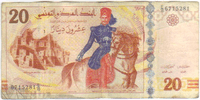 |
 |
20 dinars | Red, blue, and yellow | Kheireddine Et-Tounsi, Ksar Ouled Soltane fortified granary in Tataouine district | L’École Sadiki (Sadiki College) building in Tunis |
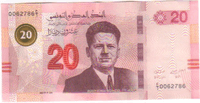 |
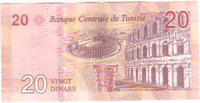 |
20 dinars | Red | Farhat Hached | Amphitheater of El Djem |
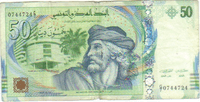 |
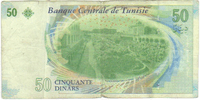 |
50 dinars | Green, blue, and orange | Ibn Rachik, Musée de la Monnaie (Currency Museum) building in Tunis | Place Gouvernement la Kasbah, central square in Tunis |
| Demonetised banknotes | |||||
|---|---|---|---|---|---|
| Image | Value | Main Color | Description | ||
| Obverse | Reverse | Obverse | Reverse | ||
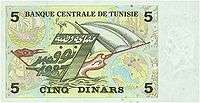 |
5 dinars | Green | Hannibal, Port Punique (Carthage) | Motif commemorating the overthrow of Habib Bourguiba on 7 November 1987 | |
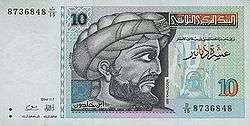 |
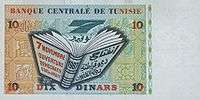 |
10 dinars | Blue | Ibn Khaldoun | Motif commemorating the overthrow of Habib Bourguiba on 7 November 1987 |
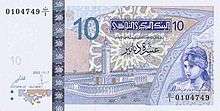 |
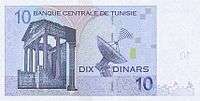 |
10 dinars | Blue | Elissa (Dido) Instituted after the United Nations IT conference in Tunis 2006. | Sbeitla temple, satellite dish |
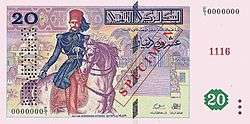 |
 |
20 dinars | Purple | Kheireddine Et-Tounsi | Motif commemorating the overthrow of Habib Bourguiba on 7 November 1987 |
 |
 |
30 dinars | Green, orange | Aboul-Qacem Echebbi | Tunisian farm with goats and ”TRENTE DINARS” written above |
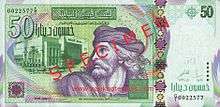 |
50 dinars | Green and purple | Ibn Rachik, the City of Culture building | Rades bridge over ship canal to Tunis, Enfidha-Hammamet International Airport (formerly Zine el-Abidine ben Ali Airport; renamed after President el-Abidine left the country in 2011) | |
Popular nomenclature
Tunisians sometimes do not use the main division, dinar, when mentioning prices of goods. Accordingly, one dinar and a half, is often referred to as khomstach en miya (literally fifteen hundred). This applies to all prices below 2 dinars. 50 dinar is often referred to as khamsin alf (fifty thousand). This convention is used even for higher prices, for example 70,000 dinars would be called sab'in maliun (seventy million). "Francs" is also still heard from time to time, 1000 of them colloquially representing a single dinar. In addition to that, tunisians tend to use the word "Frank" instead of Millime. For example, 100 millimes (0.1 Dinars) is referred to as "miyat frank" (Literally 100 franks). The word Frank is originated from French colony era.
Currency restrictions
It is a criminal offence in Tunisia to import or export dinar. Every year, each citizen can convert into foreign currency up to 6,000 Tunisian dinars before departure from the country.[8] Therefore, prices at duty-free shops are in convertible currencies such as euros, US dollars and British pounds. There are many converting ATMs in the country for tourists.
| Current TND exchange rates | |
|---|---|
| From Google Finance: | AUD CAD CHF EUR GBP HKD JPY USD |
| From Yahoo! Finance: | AUD CAD CHF EUR GBP HKD JPY USD |
| From XE.com: | AUD CAD CHF EUR GBP HKD JPY USD |
| From OANDA: | AUD CAD CHF EUR GBP HKD JPY USD |
| From fxtop.com: | AUD CAD CHF EUR GBP HKD JPY USD |
eDinar
There is some speculation that there is an eDinar using blockchain technology. It appears this is an initiative of the Tunisian Postal Service and not the Central Bank and that there is no national e-currency.
See also
- Economy of Tunisia
- Carthaginian shekel
- Denarius
- Tunisian rial or piastre
- Tunisian franc
References
- "Roman silver coins: denarius". www.monete-romane.com. Retrieved 22 August 2018.
- "Currency Museum of the Central Bank". Central Bank of Tunisia. December 12, 2004. Archived from the original on December 12, 2004.
- "Tunisie: Deux nouvelles pièces de monnaie en circulation", Al Huffington Post Maghreb, 26 december 2013
- Linzmayer, Owen (2013). "Tunisia". The Banknote Book. San Francisco, CA: www.BanknoteNews.com.
- Tunisia BanknoteNews.com. Accessed on 2009-09-28.
- https://mriguide.com/tunisia-demonetized-banknotes/
- https://www.tustex.com/economie-actualites-economiques/tunisie-la-bct-etudie-le-retrait-des-billets-de-50-dinars
- "Banque Centrale de Tunisie". Retrieved 22 August 2018.







